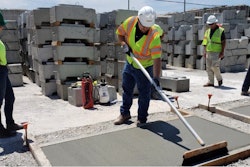 Antelope Point Marina in Glen Canyon National Recreation Area on Lake Powell in Utah in 2010. The Antelope Point breakwater was damaged by high winds in May. Photo credit: National Park Service
Antelope Point Marina in Glen Canyon National Recreation Area on Lake Powell in Utah in 2010. The Antelope Point breakwater was damaged by high winds in May. Photo credit: National Park ServiceContractors who have national parks in or near their territory should keep an eye out for possible road and bridge work and other infrastructure projects.
That’s because the recently passed Great American Outdoors Act, which calls for spending $9.5 billion over 5 years to restore facilities and infrastructure in national parks and public lands, according to the White House. It also fully funds the Land and Water Conservation Fund, which uses royalties from oil and gas companies drilling offshore to protect parks and environmentally sensitive public lands from development as well as provide grants for state and local parks and recreation projects.
“This is the biggest investment in our national parks in nearly 65 years,” says the Pew Charitable Trust, which is among the conservation and nonprofit groups that fought for the new law. Pew says infrastructure work on the parks could begin as soon as October.
It’s also being hailed as a job-creation plan, possibly resulting in 100,000 new jobs, according to the National Park Service.
“The act will help sustain the 5.2 million American jobs the recreation industry supports each year — spending from park visitors alone supports over 340,000 jobs annually — and a recent National Park Service analysis projects that it will generate an additional 100,000 park-related jobs,” Pew says.
The park service reports that as of fiscal year 2018, it had $11.9 billion in deferred maintenance, which includes close to 6,000 miles of paved roads, 21,000 miles of trails and 25,000 buildings. The service adds that more than half of the maintenance is transportation-related.
“Two-fifths of all paved roads in national parks are rated in ‘fair’ or ‘poor condition,’” a park service report says. “Dozens of bridges and trails are in need of rehabilitation or reconstruction.”
The California Asphalt Pavement Association praised the bipartisan support for the legislation and hoped to see such cooperation on a broader national infrastructure plan.
“This is a good example of what can be accomplished when industry and other organizations work together toward a common goal,” the association says. “It is our hope that this can serve as an example for establishing stable and dependable funding for the rest of America’s failing infrastructure, providing thousands of good jobs for hard-working Americans.”
CalAPA estimates the law will be of particular help to California, where it has estimated deferred maintenance of $1.8 billion, including roads and parking lots, according to the National Park Service.
“The National Park System supports more than 35,000 jobs in California and attracts more than 41 million visitors each year,” CalAPA says.
Others with park maintenance backlogs over $100 million, according to the National Park Service:
- District of Columbia: $1.3 billion
- Virginia: $1.1 billion
- New York: $871 million
- Wyoming: $771 million
- Arizona: $507 million
- North Carolina: $459 million
- Washington: $427 million
- Mississippi: $326 million
- Pennsylvania: $314 million
- Maryland: $293 million
- Tennessee: $291 million
- Nevada: $252 million
- Colorado: $248 million
- Massachusetts: $244 million
- Florida: $240 million
- New Jersey: $223 million
- Utah: $219 million
- Hawaii: $165 million
- Texas: $154 million
- Oregon: $127 million
- New Mexico: $121 million
- Ohio: $114 million
- Kentucky: $111 million
- Georgia: $107 million
To see more details of deferred maintenance with state-by-state breakdown, click here.













